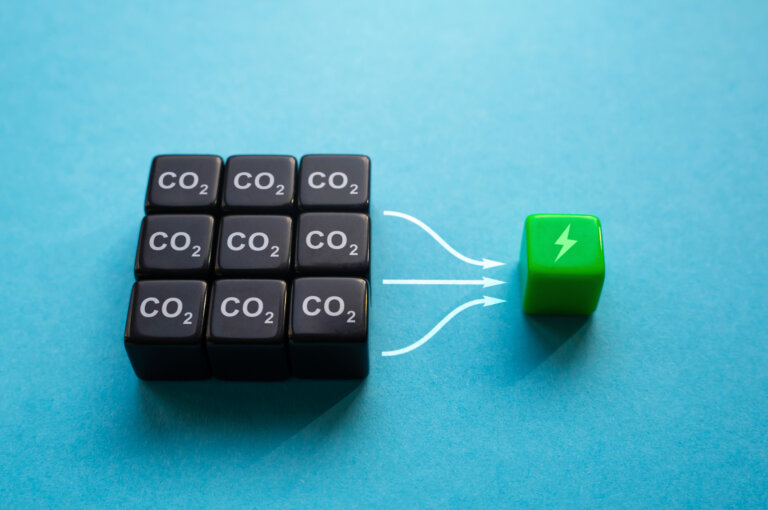
Written by Stuart Simmonds – VP Business Development & Marketing
October 16, 2025
Every year, human activity releases close to 38 gigatonnes of carbon dioxide (CO₂) into the atmosphere. Over time, these emissions have had a significant impact on the planet’s natural ecosystem. Atmospheric CO₂ has risen from roughly 300 parts per million (ppm) at the start of the 20th century to 424 ppm in 2025, the net result now being 50 percent increase since the beginning of the industrial revolution.
This rapid rise in atmospheric CO2 is directly linked to the use of fossil fuels. These fuels hold carbon that was captured over millions of years through photosynthesis. When burned to power industries, vehicles, or electricity generation, or used in a myriad of manufacturing processes, that ancient carbon is released back into the atmosphere in the form of CO2.
To counter this imbalance, industries and governments are turning toward Carbon Capture, Utilization, and Storage (CCUS) — a group of technologies designed to capture carbon dioxide before it reaches the atmosphere and either reuse it in industrial applications or store it safely underground.
Far from being a futuristic concept, CCUS is already transforming how we think about energy, manufacturing, and environmental responsibility.
What you’ll learn:
How carbon capture works and the main technologies behind it
What happens to captured CO₂ and how it can be stored safely
How industries are reusing CO₂ in practical, value-driven ways
Why CCUS plays a central role in achieving global climate targets
Understanding How Carbon Capture Works.
At its core, carbon capture isolates CO₂ from other gases produced during combustion or industrial processes. There are several approaches to carbon capture that are being used and refined today, depending on the source of emissions and the type of facility.
Post-combustion capture removes CO₂ from flue gases after fuel has been burned. It is the most adaptable approach and can be integrated into most existing industrial processes, such as the refining and petrochemical industries, power generation, metals and mining industries, for example.
Pre-combustion capture works earlier in the process, removing CO₂ before the fuel is burned. The fuel is converted into hydrogen via a syngas process, and CO is converted to CO₂, pre-combustion. This allows the hydrogen to be used as a clean energy source while the CO₂ is captured and contained.
Oxy-fuel combustion uses pure oxygen instead of air for burning fuel. This produces a flue gas that is almost entirely CO₂ and water vapour, simplifying separation and recovery process.
Beyond these industrial methods, Direct Air Capture (DAC) offers a way to remove CO₂ directly from the atmosphere. Though energy-intensive, DAC represents a crucial step toward net-negative emissions and is currently being researched and deployed in many countries, including Canada.
Where Does the Captured Carbon Go?
Once captured, CO₂ can follow one of two main paths: utilization or sequestration.
In geological sequestration, the CO₂ is compressed into a dense fluid and injected deep underground into carefully selected rock formations. Common storage sites include:
- Depleted oil and gas reservoirs, which have demonstrated natural containment for millions of years
- Deep saline aquifers, offering vast storage capacity worldwide
- Unmineable coal seams, where CO₂ can attach to coal surfaces while displacing methane
Storage sites are evaluated for safety, integrity, and storage capacity. After injection, the CO₂ is closely monitored using sensing and modelling systems. Over time, it dissolves in formation water or reacts with surrounding minerals to form stable compounds, ensuring permanent containment.

From Waste to Resource: Industrial Uses for CO₂.
Not all captured CO₂ is stored underground. Many industries are now finding innovative ways to reuse it.
In enhanced oil recovery (EOR), CO₂ is injected into mature oil fields to improve recovery rates while trapping a portion of the gas underground. In the chemical sector, it serves as a raw material in the production of methanol, urea, and synthetic fuels.
The construction industry is also using CO₂ to produce low-carbon building materials by converting it into mineralized concrete. Even in the food and beverage industry, purified CO₂ plays a role in carbonation, refrigeration, and packaging.
These applications not only reduce waste but also help industries create value from what was once a byproduct of combustion.
Transporting the Captured Carbon.
Once captured, CO₂ must be transported to its final destination. The most common method is through pipeline transmission.
Across North America, thousands of kilometers of CO₂ pipelines already operate primarily for industrial applications and enhanced recovery. These pipelines are designed to handle high-pressure CO₂ and are monitored continuously for safety and integrity.
As CCUS projects expand, developing interconnected CO₂ pipeline networks will be essential to link emission sources with utilization and storage sites efficiently.
Meeting Climate Targets Through CCUS.
Governments around the world recognize that achieving net-zero emissions by 2050 will not be possible without carbon capture technologies.
Countries such as Canada and the United States have introduced significant incentives to accelerate CCUS deployment, including tax credits, grants, and research funding. These initiatives aim to reduce costs, scale infrastructure, and promote adoption across heavy industries.
While challenges remain — particularly the high capital cost of capture systems — innovation and collaboration are steadily improving efficiency and lowering barriers to implementation.
Every process is different — our team can help you explore the right CCUS technologies for your application.
Looking Ahead.
Carbon Capture, Utilization, and Storage represents one of the most pragmatic approaches to decarbonizing heavy industry. It allows essential sectors like power generation, cement, steel, and chemicals to continue operating responsibly while reducing their environmental impact.
In the next articles of the Carbon Capture in Focus series, we will take a closer look at each part of this process — from the science behind capture systems to the engineering of safe underground storage, and the growing role of CCUS in global sustainability efforts.
The path to a lower-carbon future is not about abandoning industry. It is about transforming it.
Be the first to read our articles

Written by Stuart Simmonds – VP Business Development & Marketing
Write to Stuart at: stuart.simmonds@novatech.ca

